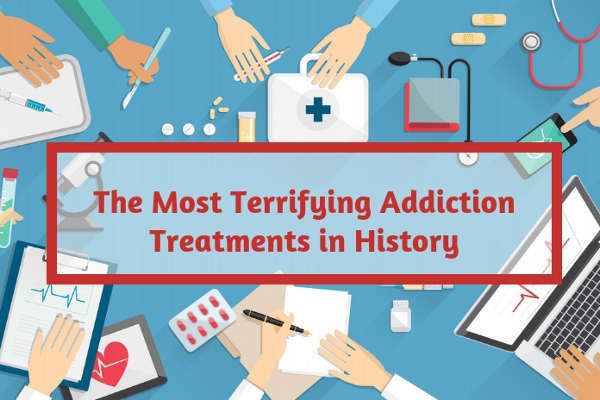Over the centuries, people have dealt with all sorts of misconceptions when it comes to healthcare. Addiction is no exception. Before modern science identified addiction as a disease and offered compassionate treatment options, rehab was downright terrifying.


We now understand that addiction is a chronic brain disease that creates a disproportionate reward response to certain drugs and activities. Now, places like A Better Today Recovery Services offer comprehensive and compassionate support that’s a far cry from the experimental treatment used long ago.
Aversion Therapy
Most of us have heard of therapeutic methods that teach us to associate drugs and alcohol with something really bad. Creating a relationship between something that a person is addicted to and something that disgusts or terrifies them can be effective under certain circumstances. Unfortunately, it’s not always done in the most humane way.
Drugs like Antabuse have the same effect as a negative association by making people sick when they drink alcohol. This creates an unpleasant reaction to drinking that’s supposed to train the alcoholic to feel the same way about alcohol as they do about vomiting. This method may work to deter the addict, but it rarely sticks—plus they have to agree to take it in the first place.
At the turn of the century, the medical community had pretty close to the same idea. They would place the alcoholic in an enclosed environment, sometimes lined with mirrors, and give them a drink. After drinking, the doctors would give them something to induce vomiting or extreme nausea. They hoped that the patient would create a relationship between the two feelings and then stop drinking. Needless to say, it failed.
When those types of aversion therapies weren’t working for addicts, doctors tried mixing the drugs with absolutely foul ingredients. This included rotting food, animal feces, and even live fish. They finally got the point when the newest tactic, electric shock aversion therapy, was doing more harm than good and took a more modern approach to treat addiction.
Morphine for Alcoholism
If this sounds counterproductive, that’s because it is. In the late 19th century doctors believed morphine was a cure-all. They gave the drug to pregnant women, children, and anyone suffering from an unknown malady. So, it made perfect sense when they decided to give it to addicts.
At the time, alcoholism was looked at like a dirty or “low-class” addiction, whereas morphine was more socially acceptable and used for medicinal purposes. This meant that even if the person who was addicted to alcohol or something else became dependent on morphine, doctors still thought they were succeeding. Obviously, this type of “treatment” didn’t last long and eventually gave way to a more serious problem.
The Serum Therapy of the 1950s
This was a particularly nasty experiment that took place primarily in the Colorado State Penitentiary during the 1950s. Doctors took the opportunity to force addicts to undergo experimental treatments that were cruel and unusual. One of these involved inducing a series of blisters across the addict’s stomach and back. Once these blisters had developed, doctors would use a hypodermic needle to remove the fluid.
Once they had obtained the fluid, they would then reinject it into the patient’s arm. This process went on at least twice a day for up to one week. If you can imagine how painful and disturbing this would be, it makes you grateful for the progress in treatment methods today.
Serum therapy was, fortunately, short-lived. This was followed by a method that attempted to extract fluid from the adrenal glands and to reintroduce this to the addict’s bloodstream. Doctors thought that addiction was a disease of the adrenal cortex and tried to fight fire with fire. It obviously didn’t work.
As cruel of these methods are, they really give us insight into how desperate people were to control addiction even then.
The Frontal Lobotomy
It seems like doctors during the late 50s and 60s became “lobotomy happy” when they discovered how effective this could be for controlling aggressive and violent patients. While doctors were still pretty clueless about the way that the brain worked, they still realized that addiction was directly tied to the prefrontal cortex.
In 1936, a psychiatrist by the name of Walter Freeman performed the very first human lobotomy. Once he figured out that drilling random holes in the human head was a little messy, he developed the legendary ice pick procedure.
A long, sharp, pick-like device was inserted into each of the patient’s eye sockets and moved in such a way as to sever the connections to the frontal lobe. This wasn’t always an exact science but it appeared effective with people who were prone to mania or impulsive behaviors like addiction.
Understanding the evolution of addiction treatments can provide valuable insights. For more details on modern approaches and options available, you can access information from Pacific Ridge. This resource offers comprehensive guidance on current treatment methods and facilities, helping to navigate the path to recovery effectively.
Essentially, the frontal lobotomy was separating a person from their emotional being. Sure, it was effective, but it also had zombielike results for the majority of the patients. Frontal lobotomies were still done clear into the 1980s before they were largely stopped in the US.
Psychedelics
This is still a widely debated treatment option for addiction. There are clinics operating in other countries that offer access to psychedelic drugs like LSD or ibogaine in order to significantly impact the brain chemistry.
There have been studies that show that ibogaine is highly effective in the treatment of opiate addiction, but it’s also very dangerous. The drug can have lasting effects on a person’s heart and cause permanent damage to their cardiovascular system.
Because of the number of deaths associated with clinical trials, it was completely outlawed in the U.S. by 1970. There was some additional research done in the 90s, but they were still unable to manage the risks; the bad completely outweighed the good.
We Still Have a Long Way to Go
Thankfully, the treatment of addiction has evolved immensely since these archaic methods were used. With new technology and new research, there’s more hope than ever that doctors will be able to effectively wipe addiction out one day.

























